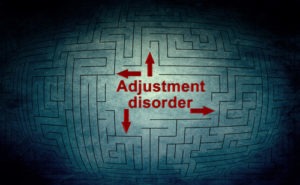
VA Compensation for Adjustment Disorders — Everything You Need To Know
If you received a diagnosis of an adjustment disorder after serving in the military, you could be eligible for Veterans Affairs (VA) disability. If you apply and get approved for disability, you could begin receiving monthly compensation and other ancillary benefits. A VA disability advocate can help you submit a compelling appeal for adjustment disorder veterans’ benefits.
For a consultation, call today at (888) 373-4722.
Receiving VA Disability Benefits for Adjustment Disorder
Adjustment disorder is a psychological disorder that sometimes arises in response to a stressful event, such as a major life change or the loss of a loved one.
Many people confuse adjustment disorder with post-traumatic stress disorder (PTSD). While the two conditions share similarities, they are not the same thing. PTSD occurs most often as the result of a life-threatening or traumatic event. Adjustment disorder, in contrast, usually arises from something more benign. And while PTSD is often permanent, adjustment disorder rarely is.
Adjustment disorder has its own listing in the VA Schedule for Rating Disabilities. With a valid diagnosis, an in-service event or onset and medical nexus opinion, you can apply for and receive disability benefits. Our advocates want to talk to you and find out how they can help. If you suffer from adjustment disorder, call Disabled Vets today for help at (888) 373-4722.
Our VA Disability Advocates Can Build a VA Disability Case on Your Behalf
The right advocate can develop a compelling case for VA disability benefits on your behalf. For your appeal to be successful, your case must prove two things, a valid diagnosis and the adjustment disorder is service-related.
You Have a Valid Diagnosis of Adjustment Disorder
You first have to present a valid diagnosis of adjustment disorder from a doctor or mental health professional. Our advocacy group reviews all your medical records, doctors’ statements, and other evidence to obtain supporting documentation that makes it clear you meet the diagnosis requirement.
Your Adjustment Disorder Is Related to Your Service
Your case must also establish that your condition is connected to a specific event that took place during your military service or that your condition started (or was aggravated) during your military service.
VA’s Criteria of a Disability
To decide whether your condition is eligible for benefits, a VA disability advocate will also look at how seriously your condition affects your quality of life and ability to function. In other words, does your condition keep you from working and/or otherwise impact your day to day life? And if so, to what extent?
The answers to these questions determine how much compensation you would receive each month if you get approved.
We can gather evidence and assemble it into a compelling picture of your condition and how it affects you.
Let a VA Disability Advocate Fight for the Benefits You Deserve
When our advocates take your VA disability case and start building your appeal for benefits, they do so with two goals in mind. First, they want to make sure you get approved, preferably on the first try. Second, they want your appeal to be so compelling that you receive the highest possible disability rating.
VA rates your disability on its severity and how significantly your daily life is affected by it. You receive more monthly compensation the higher your rating is. Adjustment disorder is rated as a psychological disorder, which can receive either a 10, 30, 50, 70 or 100% rating.
As of December 2019, here are the monthly disability compensation rates:
- 10% disability rating: $142.29 per month
- 30% disability rating: $435.69 per month
- 50% disability rating: $893.43 per month
- 70% disability rating: $1,426.17 per month
- 100% disability rating: $3,106.04 per month
*The above numbers are based on a single veteran with no dependents
VA uses the following schedule of ratings to determine which disability level you will receive:
- 100% rating: “Total occupational and social impairment, due to such symptoms as gross impairment in thought processes or communication; persistent delusions or hallucinations; grossly inappropriate behavior; persistent danger of hurting self or others; intermittent inability to perform activities of daily living (including maintenance of minimal personal hygiene); disorientation to time or place; memory loss for names of close relatives, own occupation, or own name.”
- 70% rating: “Occupational and social impairment, with deficiencies in most areas, such as work, school, family relations, judgment, thinking, or mood, due to such symptoms as suicidal ideation; obsessional rituals which interfere with routine activities; speech intermittently illogical, obscure, or irrelevant; near-continuous panic or depression affecting the ability to function independently, appropriately and effectively; impaired impulse control (such as unprovoked irritability with periods of violence); spatial disorientation; neglect of personal appearance and hygiene; difficulty in adapting to stressful circumstances (including work or a work-like setting); inability to establish and maintain effective relationships.”
- 50% rating: “Occupational and social impairment with reduced reliability and productivity due to such symptoms as: flattened affect; circumstantial, circumlocutory, or stereotyped speech; panic attacks more than once a week; difficulty in understanding complex commands; impairment of short and long-term memory (e.g., retention of only highly learned material, forgetting to complete tasks); impaired judgment; impaired abstract thinking; disturbances of motivation and mood; difficulty in establishing and maintaining effective work and social relationships.”
- 30% rating: “Occupational and social impairment with occasional decrease in work efficiency and intermittent periods of inability to perform occupational tasks (although generally functioning satisfactorily, with routine behavior, self-care, and conversation normal), due to such symptoms as depressed mood, anxiety, suspiciousness, panic attacks (weekly or less often), chronic sleep impairment, mild memory loss (such as forgetting names, directions, recent events).”
- 10% rating: “Occupational and social impairment due to mild or transient symptoms which decrease work efficiency and ability to perform occupational tasks only during periods of significant stress, or; symptoms controlled by continuous medication.”
- 0% rating: “A mental condition has been formally diagnosed, but symptoms are not severe enough either to interfere with occupational and social functioning or to require continuous medication.”
Call Today for a Free Case Evaluation Today: (888) 373-4722



